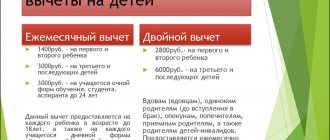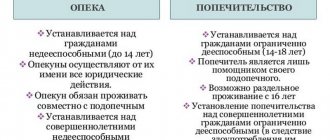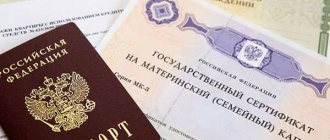Life situations in which women are left alone, live separately from their husbands and raise children on their own are not so rare. Among them, single mothers are singled out. This status is determined by the following:
- The child was born outside of an official marriage.
- The mother is the only parent of the born child.
- Paternity has not been established in fact, therefore there is no record of the father on the child’s birth certificate.
A woman can be recognized as a single mother in other, often not entirely standard, situations. For example, a woman is not married, but she adopted someone else’s child and is raising him herself. Or she is officially married and has adopted a child, but her husband refused to participate in the adoption procedure.
The main document certifying a woman’s actual status is still a child’s birth certificate. If there is a dash in the “father” column, then the child has only one parent – the mother. Her status is then defined as a single mother. She and her child are an incomplete family.
This certificate is necessary not only to confirm the real status of the woman, but also to register the benefits she is entitled to.
Important! There are no separate privileges for women with single mother status at the federal or regional level. They can receive benefits on a general basis, and also if her family is recognized as low-income or with many children.
the federal law
For single mothers, there is no separate regulatory act that would spell out all the required benefits and guarantees. State support for this category of mothers is detailed in regional legislation, where a specific term and a detailed list of benefits are introduced.
It is generally accepted that a single mother is a woman who gave birth to a child out of wedlock. Or at the time of registration of the child there is no joint application by the child’s parents to establish paternity. There is a dash in the “father” column of the birth certificate.
Answers to frequently asked questions
Question No. 1: The child was born into a full-fledged family, he had both parents. But then paternity was disputed after some time. Is the woman a single mother?
Here the dominant role is played by the fact of establishing paternity. If it is established, then, accordingly, the child has two parents and the woman does not acquire this status. And vice versa, if paternity has not been established, then the only parent for this child is his mother, who will be recognized as single under these circumstances.
Question No. 2: The natural father is deprived of parental rights (or limited in them). Is the child's mother single?
No, because the child has a natural father and he is indicated on the child’s certificate. The fact of subsequent deprivation (restriction) of rights does not mean the fact that the child does not (did not have) a father.
A similar situation is when the father is missing (“disappeared”). The mother of a child whose father “disappeared” is not recognized as a single parent, because even if he is actually absent, his full name is recorded in the child’s birth certificate under the “father” column.
Single mother of many children
A single mother, like two-parent families, must confirm her status of having many children. To do this, a package of documents is submitted to the social protection authorities, which may differ slightly by region of the country.
When you have a certificate for a mother of many children, a single person can count on federal and local benefits. Federal benefits apply to large families, without singling out single mothers:
- free provision of prescription medications for children under 6 years of age;
- extraordinary receipt of a place in kindergartens;
- priority receipt of vouchers to children's health camps or sanatoriums;
- free provision of school uniforms or sets of clothes for classes, including sports;
- extraordinary registration to receive subsidies for improving housing conditions;
- compensation for kindergarten fees in the amount of at least 50% for the second and at least 70% for the third and subsequent children.
At the regional level, support for a single mother with many children consists of:
- one-time, monthly or annual payments;
- natural assistance;
- providing benefits;
- organization of free social services.
For example, in Moscow it is:
- monthly compensation to cover the cost of rising food costs;
- compensation for payment for housing and communal services and landline telephone;
- free public transport for mothers and children;
- obtaining a parking permit, which allows you to park your car in a paid parking zone for free at any time during the year;
- free two meals a day for children at school;
- free leisure or with big discounts. This applies to visiting museums and exhibitions.
Read: What benefits are available to large families.
Benefits for single mothers
Women who have the status of single mother are entitled to:
- general benefits provided for all Russian women;
- special payments that are provided only to socially vulnerable groups of the population.
General payments
The general payments due to all mothers without exception include:
- One-time payment for pregnancy and childbirth (the amount depends on the salary accrued to the mother in the last two years of work before going on maternity leave).
- Additional payment for 16 days of sick leave if it was extended due to a difficult birth.
- One-time benefit paid in case of early registration at the antenatal clinic before 12 weeks of pregnancy (613.14 rubles).
- A one-time payment after the birth of a child is 17,479.73 rubles.
- Benefit for a child up to one and a half years old , paid monthly in the amount of 40% of the salary accrued before going on maternity leave. If the mother is not officially employed, she has the right to receive these payments from the social protection authorities. In this case, the amount of benefit for one child will be equal to 3,120 rubles monthly, for two or more – 5,817 rubles.
- A monthly payment provided to low-income families upon the birth of the first child in the family and until the child reaches the age of 1.5 years. Size varies by region.
- Child care allowance – 50 rubles per month.
Benefit for the poor
A single mother, especially one with many children, may not always have a permanent job, which affects the financial situation of the family. Article 6 of Law No. 134-FZ of October 24, 1997 “On the subsistence level in the Russian Federation” recognizes a low-income family when the average per capita income for each member is below the subsistence level, the amount of which is established independently by a constituent entity of the Russian Federation.
Since the family includes the concept of complete and incomplete, single mothers are recognized as low-income on a general basis and they receive the right to social assistance:
- monthly allowance, the amount and procedure of which is established by regional authorities;
- lump sum benefit for the birth of the 3rd and subsequent child;
- targeted material, clothing or food.
The specific amount of state support depends on the subject of the Russian Federation where a single poor person lives, on the number of children, and their age.
For example, low-income single mothers in Moscow receive:
- free legal assistance;
- targeted social assistance;
- monthly child benefit;
- subsidy for housing and communal services;
- assistance in solving housing issues.
Read: What benefits are available to a low-income family?
Financial assistance from the state
A single mother who has a permanent job has the right to a monthly benefit for up to 1.5 years for each child born to her.
She is given a maternity certificate just like everyone else.
If a woman gives birth to her third baby , then she can apply for an appropriate monthly payment. The amount of the benefit is equal to the child subsistence level in force in the region. This financial assistance can be applied for only in 69 regions and territories of our country and only on the condition that the family is low-income.
Almost all regions congratulate the parents of the 3rd child with regional capital, but it is better to clarify the information at the MFC in accordance with the place of permanent residence, as exceptions occur.
If a single mother did not have a permanent job before pregnancy, then she will have to be content with a much smaller material amount - a minimum fixed benefit, for the payment of which the social protection of the population is responsible.
You can apply for 2 types of government payments :
- one-time, timed to coincide with the birth of the baby. The amount of the benefit does not depend on external factors, such as: wealth, amount of official income, presence of a permanent job, spouse, etc. State assistance is provided to absolutely all women who have given birth to children. This year, each mother is entitled to 16,759 rubles. 09 kop . If 2 or 3 babies are born at once, then a lump sum benefit of the same size is paid for each of them.
- monthly, duration equal to 1.5 years. If a woman did not work before the onset of an interesting situation, then she will receive the minimum amount of child care benefits for up to 1.5 years, namely: 4,465 rubles. 20 kopecks – for the 1st child and 6284 rubles. 65 kop. - on the 2nd and subsequent ones.
If a woman conscientiously performed her official duties before the birth of the baby, then she is also entitled to the following government support:
- leave related to pregnancy and childbirth (sick leave for 140 days), paid at 100% of wages;
- payment in connection with an early visit to an obstetrician-gynecologist, the amount of which is 613 rubles. 14 kopecks;
- monthly allowance for caring for a child up to 1.5 years old (the advantage is that the amount of allowance for a working woman is often much larger than for a non-working woman);
- compensation benefit in the amount of 50 rubles, paid until the child reaches 3 years of age.
Single mothers with many children often do not have a permanent job, so they are poor. In this regard, they are provided with the following additional government support :
- a monthly (quarterly) allowance, the amount and procedure of which is determined by the regional government, provided that the average per capita income for each family member does not reach the minimum required amount;
- a one-time benefit dedicated to the birth of the 3rd or subsequent child. Payment conditions: low income. The main rule is the baby’s date of birth is 01/01/2013 and later.
The amount of financial support in both cases depends on the mother’s place of residence and is regulated by local regulations.
In addition, certain regions are trying to further support their single mothers of many children:
- In the Moscow region, you can receive a one-time “Luzhkov payment” (5 subsistence minimums for the 1st child, 7 for the 2nd, 10 for the 3rd and subsequent ones). Among the main conditions are: the age of the mother - no more than 30 years and the date of birth of the baby - 01/01/2004 and later. In addition, a resident of the Moscow region receives a monthly (up to 3 years) compensation payment for groceries in the amount of 675 rubles. and inflation compensation - 750 rubles.
- Since 2015, the Board of the Kostroma Region
- A single student mother living in the Kursk region can receive a monthly payment of 900 rubles.
- The Penza region makes sure that a woman and her children have housing. So, if a mother is raising 3 or more children and is on the housing waiting list, then the region will compensate her monthly apartment rent in the amount of 6,400 rubles.
- In the Sakhalin region they are fighting the queue for preschool institutions, namely, a woman is paid 9,500 rubles a month if her child, aged 1.5 to 6.5 years, does not attend kindergarten.
Unemployed single mother
A single mother is considered unemployed if she:
- looking for a job for the first time;
- dismissed due to liquidation measures or staff reduction;
- dismissed by agreement of the parties, initiative of the employee or employer.
The law does not provide separate benefits for such an unemployed person. Therefore, a single mother, after receiving unemployed status from the Employment Service, receives unemployment benefits on general terms. The amount depends on the average monthly earnings from 75 to 45% for the payment period and on the basis for obtaining the status.
For example, first-time job seekers receive a minimum benefit of 850 rubles, adjusted by the regional coefficient.
Mortgage for a single mother
For banks, single mothers are not so much a preferential category of citizens as they are clients with increased financial risk. But the status of a single parent does not prevent a woman from participating in credit programs of Sberbank of Russia:
- Mortgage plus maternity capital. If you take out a loan from Sberbank for finished or under construction housing, you can use maternal capital funds for the down payment or part of it.
- Mortgages with state support for families with children began to operate in 2018 for families where the 2nd or 3rd child was born after January 1, 2018. The loan is issued for a period of 1 to 30 years at a rate of 6% per annum, if you have at least 20% of your funds;
- “Purchase of housing under construction”, including “Promotion for new buildings” at a rate of 6.7% per annum, if you have at least 15% of your own funds;
- “Purchase of finished housing” at a rate of 8.6% per annum.
A single mother must meet the following general conditions:
- age from 21 to 75 years;
- work experience of 6 months;
- citizenship of the Russian Federation.
Single mothers can join the Housing program created at the state level. A woman must be no older than 35 years old, have the status of needing improved housing conditions and have a regular income. Then she will receive a subsidy in the amount of 30-35% of the cost of the residential property at the expense of the state.
Read: Preferential mortgages for families with children
List of benefits provided to mothers in 2020
Upon discharge from the maternity hospital, the mother can receive the most necessary items.
Now that we have clearly understood the peculiarities of the status of a single mother, we can discuss the list of federal benefits entitled to such Russian women. First of all, they need to issue a certificate in form No. 25. After this, you can apply for benefits from the following list with social authorities:
- assistance in kind - this category includes an envelope for discharge from the maternity hospital, a supply of linen, clothing and essential medicines, as well as products issued at the dairy kitchen. The benefit is valid until the child celebrates his second birthday;
- compensation for the amounts required for feeding the baby - this benefit is valid for 36 months from the date of birth of the child;
- discounts or refunds when paying for electricity, water, gas and other types of utilities. As long as the child is under one and a half years old, you also don’t have to pay for garbage collection;
- benefits when receiving educational services (in state-owned institutions);
- the right to arrange a course of therapeutic or preventive massage for a child;
- the right to free meals for schoolchildren in the canteen;
- the possibility of priority enrollment in a preschool institution;
- the right to apply for a discount in a state-owned preschool institution that reaches ½ the amount of payment for services;
- the opportunity to take part in the “Young Family” program, since a single mother with a child is considered a separate unit of society. The main limitation for this program is the age criterion. Mom must be no older than 35 years;
- the right to carry out preventive treatment or organize a sanatorium holiday for a child at a reduced rate or free of charge (no more than once every 2 years);
- the opportunity to receive the medications your child needs for free until he is three years old. Then you can purchase them with a discount of up to 50%;
- the right to discounts when visiting government clubs or sections. Attention: this benefit does not apply to all types of sections! The maximum discount reaches 30%;
- the right to apply for a double tax deduction - as a result, the amount of taxes is reduced by 2.8 thousand rubles, and this discount applies to each child under 18 years of age;
- almost complete impossibility of being fired from work - such “insurance” is valid until the child celebrates his 14th birthday. Of course, there are exceptions - they concern persistent violators of discipline, truants and those who do not meet professional requirements and avoid work. In other cases, the woman must find a new place to work, even if the company is liquidated;
- the opportunity to take not only the main, but also an additional two-week vacation during the year (in this case, vacation pay is not accrued);
- the right to refuse night shifts, overtime hours and going to work on days that are weekends or holidays. This right is valid until the child turns 5 years old;
- the right to receive paid sick leave if the mother has to go to a hospital with her child. In the first 2 weeks, 100% of the salary is compensated, in the subsequent period - 50% of the salary. It doesn’t matter how long the mother stays in the hospital - if the child is under 7 years old, then all days will be paid for. However, if the child is over 15, then the employer accrues payments only for 15 days of sick leave;
- the ability to perform work duties within a shortened working day. This benefit is valid until the child has celebrated his fourteenth birthday.
We remind you that any benefits must be registered with the relevant authorities (housing office, social insurance), presenting a certificate and application. They are not provided automatically.
Double tax deduction
Income tax benefits for single mothers are increased amounts of standard tax deductions provided for in Article 218 of the Tax Code of the Russian Federation (hereinafter referred to as the Tax Code of the Russian Federation).
The standard child tax credit is doubled when the other parent waives it. In a single mother situation, there is no other parent, which makes it easier to obtain this type of deduction.
The standard deduction for a single mother, until her total income exceeds 350,000 rubles, is:
| Condition | Amount, in rubles |
| For the first child | 2800 |
| For a second child | 2800 |
| For the third and each subsequent child | 6000 |
| For a disabled child under 18 years old, if he is a student - up to 24 years old | 24000 |
The deduction is received for children under the age of 18 or 24 if they are full-time students.
Benefits upon dismissal
The labor rights of women with children, including single mothers, are protected by the Labor Code. These include:
- Article 263 of the Labor Code of the Russian Federation: if a child is under 14 years old or a disabled person is 18 years old, then a single parent in a collective agreement may be granted the right to additional leave at his own expense for up to 14 days;
- Article 262 of the Labor Code of the Russian Federation allows you to receive 4 paid additional days when caring for a disabled child;
- Article 64 of the Labor Code of the Russian Federation prohibits refusing to hire women because of the presence of children;
- Article 93 of the Labor Code of the Russian Federation allows the mother of a child under 14 years of age and a disabled person under 18 years of age to ask for part-time work;
- Article 259 of the Labor Code of the Russian Federation prohibits sending single mothers on business trips, bringing them to work overtime, night time, weekends and holidays if the child is under 5 years old;
- Article 261 of the Labor Code of the Russian Federation: termination of an employment contract with a single mother raising a child under 14 years of age or a disabled person under 18 years of age is prohibited.
If the organization where a single mother works is liquidated, then she is dismissed on a general basis. During liquidation, the preferential status of employees is not taken into account. But if an organization undergoes a change in organizational form or a change in staffing, then the reduction of single workers under such circumstances is impossible.
Benefits for obtaining a land plot
Single mothers do not have any benefits for purchasing land. But they can receive a free plot of land under general conditions if they meet the conditions described in Article 39.5 of the Land Code of the Russian Federation:
- For 5 years, they used free of charge a plot of land intended for individual housing construction and personal farming;
- having 3 or more children. The conditions and procedure for allocating a free plot are established by the laws of the constituent entities of the Russian Federation. Usually, this requires obtaining the status of a low-income person and in need of improved housing conditions.
In St. Petersburg
In addition to the existing methods of monetary assistance at the federal level, the authorities of St. Petersburg have provided a number of payments intended to support mothers raising their children on their own, without the participation of the father.
| Purpose | Age, years/Special conditions | Amount, rub. | Legal basis, law |
| monthly | |||
| For the purchase of children's goods and food | up to 1.5 | 3,552 (for the first) 4,058 (for the second and subsequent ones) | No. 728-132 dated 09.11.11 |
| 1,5-7 | 1 318 | ||
| 7-16 (up to 18, if studying) | 1 225 | ||
| for a disabled person, regardless of the presence of a father, 0-18 | 6 223 | ||
| per HIV-infected person, for all families, 0-18 | |||
| 0-7, if the mother has official disability status of group 1 or 2 | 6 223 | ||
| 7-18, if a parent has a disability of a similar category | 4 322 | ||
| To educate the younger generation | 3-7 | 50% living wage for the second quarter of the previous year | |
| To support the well-being of the student parent | 3 457 | ||
| If the mother gave birth to 5 or more children | 2 826 | ||
| annually | |||
| To prepare students | before 18 | 4 467 | No. 728-132 dated 09.11.11 |
| To maintain the health of a patient with celiac disease | before 18 | 10 376 | |
| once | |||
| By birth of a child | 28 257 (on the first) 37 678 (on the second) 47 096 (on subsequent ones) 52,120 (for the first, if the mother is 19-24 years old ) | No. 728-132 dated 09.11.11 | |
| Additional maternity capital | on the third or next | 100 000 | No. 810-151 dated 12/06/11 |
| Land certificate for country house construction | for families in need of improved housing conditions, priority goes to singles with many children | 300 000 | No. 710-136 dated 06.12.11 |
In addition, a mother who is a single parent can count on receiving various subsidies and compensation from the local budget. They are provided for by Federal Act No. 728-132 of November 09, 2011 and are provided to reimburse part of the payment for:
- Education of a child in a preschool educational institution:
- 40% or 70% (for a child from an incomplete low-income family, depending on income level).
- 50% (for the second child, if earnings exceed the minimum level of living),
- 70% (on the third and subsequent ones);
- 100% (if the child or parent has a disability).
- Payment of utilities if the mother has more than three children - 30-50%.
- Compensation for the use of a passenger minibus (if raising 7 or more own and adopted children under 18 years of age)
- Visiting parks, museums, exhibitions, if the mother has many children - 100%;
- Contribution for major repairs, for a parent with many children – 30-50%.
Rent subsidies
A single mother has the right to receive a subsidy for utility bills if her expenses for this exceed the maximum allowable amount in her total income. The federal standard for the maximum allowable share is 22%. But in the regions this figure may be different.
When a single person has low-income status, the share of expenses for housing and communal services is reduced by an adjustment factor. The rules for calculating subsidies are described in Decree of the Government of the Russian Federation dated December 14, 2005 No. 761 “On the provision of subsidies for the payment of housing and utilities.”
But regional authorities can establish additional benefits for single mothers.
In Moscow, they are exempt from paying for the removal of solid waste and cleaning of entrances in apartment buildings until the child is 1.5 years old. In St. Petersburg, a single mother participating in shared construction and renting housing for the duration of construction is paid compensation in the form of part of the payment for rental (sublease) services in the amount of 7,000 rubles, but not more than the entire amount under the rental agreement.
Nuances of financial assistance
It is important to understand that a woman (or a father on maternity leave) receives payments for her first child from the federal budget. The Accounts Chamber has already allocated funds for these funds.
If the limit is reached, new applicants may be left without benefits.
The payment in the name of the second child is made from maternal capital funds. The funds are allocated by the Pension Fund of the Russian Federation.
After the end of payments in 1.5 years, the maternity capital can be used as provided by law.
By the way, interestingly, “Putin’s” benefits are actually the only way to legally cash out maternity capital.
Benefits in kindergarten
The rules for enrolling children in kindergartens are established at the municipal level, so there is no single law in the country according to which all single mothers would receive an extraordinary right to enroll their child in kindergarten.
However, many regions have retained this benefit for single parents, establishing priority or priority enrollment of children in kindergartens. When registering a child for kindergarten, a single mother needs to find out what benefits are available in her region.
Paragraph 5 of Article 65 of Law No. 273-FZ of December 29, 2012 “On Education in the Russian Federation” introduces for all categories of parents the right to compensation for kindergarten fees, which is:
- from 20% of parental fees for childcare and child care in kindergarten for the first child;
- from 50% for the second;
- from 70% for the third and subsequent children.
But if a single mother has the status of having many children, then she has the right to up to a 50% discount on kindergarten fees, which does not cancel the right to compensation.
Specific amounts of compensation and discounts are established by regional legislation.
Common mistakes when receiving benefits
Error 1. A woman who is divorced and left alone with a child is not a single mother. In everyday life she is called a divorced woman. And officially it is “assigned” the status of an incomplete family. She is only entitled to alimony.
The difference between these two statuses should be properly understood. Unlike a single mother, an incomplete family (divorced woman and child) means that the child has two parents (mother, father). But they are divorced and live separately.
Error 2. You should also distinguish between two different, but very similar concepts: “low-income” and “low-income” family. Unlike a low-income family, a low-income family lives in housing conditions that are difficult to classify as normal for various reasons and simply cannot afford to improve them. She is not “tied” to the subsistence level.
A low-income family can be low-income, but the opposite situation is not possible. Typically, the total income of all members of a low-income family does not fall to or below the subsistence level.
Special cases
The list of benefits and guarantees for single mothers with a disabled child does not differ from those of a two-parent family with a disabled child. All types of benefits are conditionally divided into:
- labor, which consists of benefits for women with children and single mothers. They are only due until the child turns 18;
- housing benefits are expressed in receiving a free apartment or room, and a number of child illnesses give the right to receive an additional room, in excess of the established norms. Another type of assistance is a 50% discount on utility bills and landline telephone payments;
- social - a non-working single mother until the child turns 18 years old, according to Decree of the President of the Russian Federation dated February 26, 2013 No. 175, receives monthly assistance in the amount of 5,500 rubles. This category includes all types of social assistance provided for parents of disabled children;
- tax, when the standard tax deduction is provided in double the amount - 24,000 rubles for each disabled child.
Also, the mother of a disabled child has the right to receive an early retirement pension upon reaching 50 years of age if her insurance period exceeds 15 years.
There are cases when a single mother herself is disabled, then she has the right to a number of federal and regional benefits:
- obtaining living space;
- discount from 50% on utility bills;
- extraordinary receipt of a land plot for individual housing construction;
- free social services;
- tax standard deduction for yourself;
- preferential labor conditions;
- benefits for transport, property tax and when paying state duties.
There are no separate types of benefits for such categories of single mothers as minors or military personnel in legislative acts.
Income and benefits
What types of income are taken into account?
When calculating income for each family member, you need to add up the following types of allowance:
- wages, incl. all related payments - vacation pay, bonuses, sick leave, etc.;
- student scholarship or grant;
- pension, incl. due to disability or loss of a breadwinner (which is important for widows raising a child alone);
- social benefits;
- child support from the child's father;
- compensation payments, incl. By the tribunal's decision;
- maintenance of a military personnel;
- other income - for example, royalties from the sale of copyrights, remuneration under a civil contract, etc.
The list of income does not include gifts (for example, from relatives or ex-husband), financial assistance from the budget or from the employer.
Learn more about income verification.
Amount of income
In order to understand whether a family’s income does not exceed the maximum for receiving benefits, all cash payments received must be added up and divided by the number of family members.
The result should be compared with one and a half times the cost of living. If it turns out less, then the payment is due.
Let's look at it with an example.
A family of two (mother and son) lives in the Murmansk region, where the cost of living is 15,048 rubles.
Mom’s salary is 15 thousand rubles, her son goes to school and is dependent on her.
The mother also receives alimony in the amount of 10 thousand rubles from her ex-husband.
At the end of the year, she was paid a bonus of 50 thousand rubles at work.
In February 2020, her daughter is born from her previous marriage, and she applies for benefits.
The mother’s income for the year is: 15,000*12 + 50,000 + 10,000*12 = 350,000. Average monthly income: 350,000 / 12 / 3 = 9,723 rubles.
This is less than the subsistence minimum of 15,048 rubles, therefore, the family will be able to qualify for the “Putin” benefit.
In each region, the size of the maximum income will differ depending on the cost of living.
Income verification period
The calculation is based on the monthly income received by each family member for the 12 months preceding the application.
If for some period a person had no income, then a value equal to zero is taken for that month.
Important: only official income is taken into account. If applicants have several jobs, then income from each of them must be reflected.
Other nuances
To confirm income, you can use a standard 2-NDFL certificate. You can also provide:
- bank account statement;
- certificate on the employer's form;
- extract from the Pension Fund;
- completed tax return for the past year, etc.
If it turns out that the applicant has concealed any income, he may be forced to return the amount of benefits paid and pay a fine.
When calculating income, the income of a single mother and her children is taken into account (for example, if the child is a recipient of disability benefits or a student with a scholarship).
Who exactly does the mother live with, does she live together with other relatives, does she have an unregistered marriage - these points do not matter.
How to apply for benefits
Until 2006, single mothers received a certificate confirming their status. This document was the basis for receiving benefits. This status is not currently assigned. A woman proves her right to benefits by having in her hands a certificate in form No. 25 from the registry office, where the child’s surname is written down according to the mother, and information about the father is written down according to the mother’s words or there is a dash there.
To receive benefits, single mothers submit documents to social security authorities. A specific type of benefit requires its own set of documents.
For tax benefits, documents are submitted to the accounting department, where they are taken into account when calculating wages. If the accounting department does not do this, then the woman can submit a deduction to the tax authority.
If the benefit of a single mother is related to obtaining a plot of land, then the documents are submitted to the authorized local government body, which deals with this issue.
A woman notifies her employer about her employment benefits when applying for a job or upon the emergence of this right.
Read: What payments are due to single mothers in 2020
Design rules
The procedure for applying for child benefits requires a single mother with many children to provide the following documents:
- Birth certificate for each child.
- Certificate confirming the citizenship of children.
- Mother's passport or other document certifying personal information.
- A copy of the work record and a certificate of the woman’s monthly income.
- Certificate from the registry office in form No. 25.
- A document indicating that the children live with their mother.
If a foster child is being raised in a family, then it is impossible to do without a certificate confirming guardianship and trusteeship.
Need to remember
- Benefits for single mothers are a type of assistance that is aimed at improving the financial situation of a single-parent family.
- A single mother is a woman whose child has a dash in the father column on the birth certificate or the data is written down from her words.
- Singles are prescribed as a separate category of beneficiaries in the Labor and Tax Codes. In other cases, they receive benefits if they fit into the category of large families, low-income people, and disabled people.
- State assistance to single mothers has a federal and regional legislative basis. Expressed in material, material, social and cultural assistance.
- The status of a single mother is proven by a Certificate in Form No. 25 issued by the Civil Registry Office. They are not given certificates like mothers of many children.
- Benefits for single mothers are registered with social security authorities, and in some cases - at the place of work or with the tax authorities.
Emergency hotline for the population : we provide free consultations to pensioners, parents and beneficiaries of any category from legal experts over the phone.
Assignment of status
In order to count on government assistance, you first need to acquire status. Mothers of many children, considered single, must meet the following conditions to obtain the appropriate status:
- a woman raises three or more children, regardless of whether they are her own or adopted;
- children have not reached 18 years of age, the only exception being those who are studying full-time at a higher educational institution - then the child’s age must be no more than 23 years old;
- the mother confirms that she gave birth to children while out of wedlock, or the father has not been established, or paternity is disputed.
Thus, in order to become a mother of many children, and at the same time officially single, she must give birth to or adopt 3 or more children without being married. But when she was married, or the father is indicated in the birth document, she is not assigned the corresponding status. But if she gets married after giving birth to children, and her new husband does not adopt them, she can still become a single mother of many children, who is entitled to benefits and allowances in 2020.









